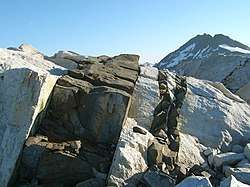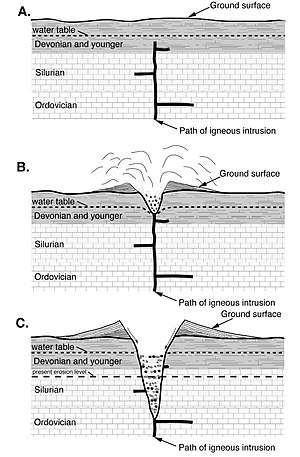Country rock (geology)
In geology, country rock is the rock native to an area, in contrast to any intrusion of viscous geologic material, commonly magma, or perhaps rock salt (in salt domes) or unconsolidated sediments.[1]


Magma is typically less dense than the rock it intrudes, widening and filling existing cracks, sometimes melting the already-existing country rock.[2]
The term "country rock" is similar to, and in many cases interchangeable with, the terms basement and wall rocks.
Country rock can denote the widespread lithology of a region in relation to the rock which is being discussed or observed.
Geologic settings
Settings in geology when the term country rock is used include:
Igneous intrusions
When describing a pluton or dike, the igneous rock can be described as intruding the surrounding country rock, the rock into which the pluton has intruded.[3]
When country rock is intruded by dyke, perpendicular to the bedding plane, it is called discordant intrusion, while a parallel intrusion by a sill indicates a sub-parallel or concordant intrusion.[4][5][2][6]
Most intrusions into country rock are via magma. Usually, country rock is intruded by an igneous body of rock which formed when magma forced upward through fractures, or melted through overlying rock. Magma then cooled into solid rock, different from the surrounding country rock. Sometimes, a fragment of country rock will break off and become incorporated into the intrusion, and is called a xenolith, from Greek, ξένος, xenos, "strange,", and λίθος, lithos, the ancient Greek word for "stone." [7]
The heat of the intrusions usually changes the country rock, often to contact metamorphic rock. Commonly, hornfels is produced, or skarn.[7]
Alluvial settings
When describing recent alluvium, the material that has arrived through volcanic, glacial or fluvial action can be described as a veneer on the (older) country rock.
References
- "Country rock - encyclopedia.com". Country rock - encyclopedia.com. encyclopedia.com. Retrieved 16 December 2018.
- Earle, Steven. "3.5 Intrusive Igneous Bodies". 3.5 Intrusive Igneous Bodies. 3.5 Intrusive Igneous Bodies. Retrieved 16 December 2018.
- Newfoundland and Labrador,
Glossary of Geological Terms Accessed June 2018.
Patricia L. Barnes-Svarney; Thomas E. Svarney (2004). The Handy Geology Answer Book. Visible Ink Press. pp. 113–. ISBN 978-1-57859-156-5. - "Hydraulic fracturing as a possible mechanism of dyke-sill transitions and horizontal discordant intrusions in trachytic tabular bodies of Arraial do Cabo, State of Rio de Janeiro, Brazil" (PDF). Hydraulic fracturing as a possible mechanism of dyke-sill transitions and horizontal discordant intrusions in trachytic tabular bodies of Arraial do Cabo, State of Rio de Janeiro, Brazil. Geofísica Internacional. 2008. Retrieved 18 December 2018.
- Granyia (June 6, 2017). "BATHOLITH…, LOPOLITH…, SILL OR DIKE? – INTRUSIONS (2)". BATHOLITH…, LOPOLITH…, SILL OR DIKE? – INTRUSIONS (2). Volcano Hotspot. Retrieved 18 December 2018.
- Khoso, Sultan Ahmed. "Intrusive Igneous Rock Structures" (PDF). Intrusive Igneous Rock Structures. miningstudents. Retrieved 22 December 2018.
- "Country rock". Country rock. encyclopedia.com. Retrieved 15 December 2018.